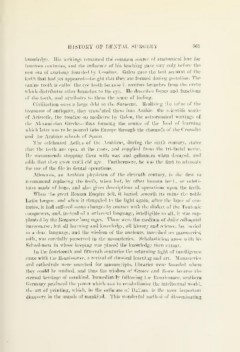Page 401 - My FlipBook
P. 401
HISTOIIY OF DENTAL SUEGEEY 361
kiio^vlo(1p:o. His writings remained the common source of anatomical lore for
fourteen centuries, and the influence of his teaching gave way only before the
new era of anatomy founded by Vesalius. Galen gave the best account of the
teetli that liad yet appeared—taught that they are fonned during gestation. The
canine tooth is called the eye tooth because it receives branches from the nerve
which distributes other branches to the eye. He describes forms and functions
of the teeth, and attributes to them the sense of feeling.
Civilization owes a large debt to the Saracens. Eealizing the value of the
treasures of antiquity, they translated them into Arabic—the seientifie works
of Aristotle, the treatise on medicine by Galen, the astronomical writings of
(lie Alexandrian Greeks—thus forming the source of the flood of learning
which later was to be poured into Europe through the channels of the Crusades
and the Arabian schools of Spain.
The celebrated Aetius of the Arabians, during the sixth century, states
that the teeth are open at the roots, and supplied from the tri-facial nerve.
He recommends stopping them with wax and galbanum when decayed, and
adds that they grow until old age. Furthermore, he was the first to advocate
the use of the file in dental operations.
Albucasis, an Arabian physician of the eleventh century, is the first to
recommend replacing the teeth, when lost, by other human teeth, or substi-
tutes made of bone, and also gives descriptions of operations upon the teeth.
Wlien the great Eoman Empire fell, it buried beneath its ruins the noble
Latin tongue, and when it struggled to the light again, after the lapse of cen-
turies, it had suffered many changes by contact with the dialect of the Teutonic
conqucrers, and, instead of a universal language, intelligible to all, it was sup-
planted by the Romance languages. These were the medium of daily colloquial
intercourse: but all learning and knowledge, all history and science, lay buried
in a dead language, and the wisdom of the ancients, inscribed on manuscript
rolls, was carefully preserved in the monasteries. Scholasticism arose with its
School-men in whose keeping was placed the knowledge then extant.
In the fourteenth and fifteenth centuries the returning liglit of intelligence
came with the Eenaissance, a revival of classical learning and art. jMonasteries
and cathedrals were searched for manuscripts, libraries were founded where
they could be studied, and thus the wisdom of Greece and Eome became the
eternal heritage of mankind. Immediately following the Eenaissance, southern
Germany produced the jiower which was to revolutionize the intellectual world,
the art of printing, which, in the estimate of Hallam, is the most important
discovery in the annals of mankind. This wonderful method of disseminating


